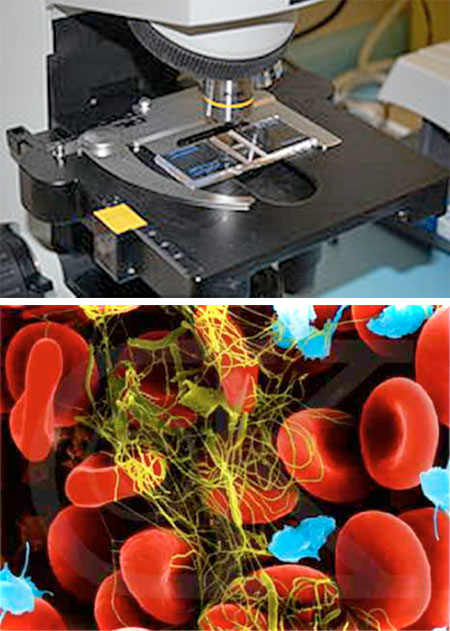Hematology

Microscopes and blood cells
The Hematology Laboratory operates 24 hours a day, 7 days a week including holidays for testing for the detection of and monitoring of hematologic disorders of the formed elements of the blood. These disorders include anemias (low red blood counts) leukemias and lymphomas (abnormal white blood cell diseases). These tests also aid in the diagnosis of infections.
Operation Schedule and Staffing
The Hematology Laboratory operates 24 hours a day, 7 days a week including holidays for testing for the detection of and monitoring of hematologic disorders of the formed elements of the blood. These disorders include anemias (low red blood counts) leukemias and lymphomas (abnormal white blood cell diseases). These tests also aid in the diagnosis of infections. Clinical Microscopy is performed in the urinalysis section of the Hematology Laboratory, Room A2-427.
Test Ordering
All ordering of tests, whether routine or emergency, must be transmitted through the computer (CERNER) unless the computer is not operational.
Contact Us
For detailed information on tests, specimen collection requirements, test schedules and turn around times, contact:
Hematology Laboratory
Location: A2- 437 (Second floor UHD)
718-270-1654 / 718-270-4332 (fax)
Raavi Gupta, MD
Director of Hematology, Coagulation & Urinalysis
718-270-1673 (office)
raavi.gupta@downstate.edu
Shanique Rankine-Kavanagh
Supervisor
718-270-1682 (office)
shanique.rankine-kavanagh@downstate.edu
Specimen Collection
All specimens must be labeled with a CERNER barcode label, including the date and time of specimen collection. If the computer is not functioning, label the specimen with the patient’s name, financial number and location.
Hematology and coagulation testing routinely utilizes anticoagulants. Mixing of all test tubes by gently inverting the tubes is important for anti clotting. Clotted specimens are to be discarded.
Coagulation testing requires 3.2% liquid sodium citrate as the anticoagulant. UHD stocks the 2.7mL draw plastic blue stopper vacutainer tube, which contains 0.3 mL of the anticoagulant. The ratio of blood to anticoagulant must be 9:1 to obtain accurate results. Minimum fill allowable is 90% (2.4 mL). Do not under fill or overfill these tubes.
Exception: polycythemic patients (hematocrit >55%). Ratio must be 19:1 (1.9 ml blood added to 0.1 ml of anticoagulant). Contact laboratory to obtain specially prepared tube.If unable to collect coagulation specimen by venipuncture and specimen must be drawn through an indwelling catheter, the line must be flushed with 5mL of saline and the first 5mL of blood or six dead space volumes of the catheter discarded.Specimens for Coagulation testing must be received within 4 hours of collection.
Hematology testing requires K2EDTA as the anticoagulant. UHD stocks the 3 mL lavender stoppered tubes and the 500 mL lavender microtainer tubes.
Clinical Microscopy (Urinalysis) Testing requires 10 mL of preferably the first-morning voided urine specimen. However, any random urine specimen is acceptable.
The urine specimen should be tested with 1-2 hours of collection. If the specimen cannot be delivered to the laboratory within this time period, it should be refrigerated as soon as possible after collection and a notation to this effect written on the specimen.Collect the specimen in a clean, leak proof, particle-free inert container.Clean Voided Specimen Collection using the Mid-Stream Urine Collector Kit.
- Wash hands with soap
- Remove towelettes.
- Cleanse genital area with towelettes.
Females: Separate folds of urinary opening with thumb and forefinger and clean inside with towelettes, using downward strokes only; keep separate during urination into container.
Males: Clean head of penis.
Remove collection device. DO NOT TOUCH INSIDE OF RING OR CONTAINER.Begin urination into toilet. As urination continues, bring container into stream. FILL SPECIMEN CONTAINER ONLY HALFWAY.Remove ring from container by twisting.Remove cap from package with thumb and forefinger. DO NOT TOUCH INSIDE OF CAP.
Screw cap on container.
Use of the APTT to Monitor Heparin Therapy: Heparin is a rapidly acting anticoagulant commonly used in the prophylaxis and initial treatment of acute thromboembolic disease. Inadequate therapy is associated with progression recurrence of thrombosis while excessive therapy may be associated with serious bleeding. As the individual response to a given dose of unfractionated or standard heparin (SH) therapy varies, therapy should be monitored. This is not the case with the newer low molecular weight heparin (LMWH) and heparinoids (see below).APTT test systems vary in their response to the concentration of standard heparin. The target therapeutic range for treatment of acute thromboembolic disease is a heparin concentration of approximately 0.2 - .0.5 Units ml, which usually corresponds to an APTT elevation of 1-2 times the patient’s baseline (pre-heparin) APTT.Many factors may interfere with the response to heparin including concurrent medications and the concentration of heparin binding proteins, which are frequently elevated in patients with thromboembolic disorders. LMWH and heparinoids are less affected by this phenomenon and thus the dose response is more predictable and rigid laboratory monitoring is not required. Where it is the APTT appears to be unreliable and a direct assay of LMWH heparinoid concentration and or effect on thrombin generation will be required.Specimen Delivery:Deliver all specimens to the Laboratory Central Accessioning Room A2-428.